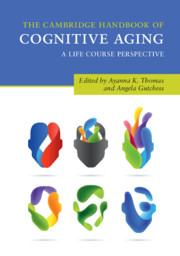Book contents
- The Cambridge Handbook of Cognitive Aging
- The Cambridge Handbook of Cognitive Aging
- Copyright page
- Contents
- Figures
- Tables
- Contributors
- Introduction
- Part I Models of Cognitive Aging
- Part II Mechanisms of Cognitive Aging
- Part III Aging in a Socioemotional Context
- 15 Memory and Aging in Social Contexts
- 16 Emotion Regulation in Adulthood and Old Age: A Cognitive Aging Perspective on Strategy Use and Effectiveness
- 17 Changes in Social and Emotional Well-Being over the Lifespan
- 18 Aging and Cognitive Functioning: The Impact of Goals and Motivation
- 19 Social Relationships and Cognitive Development in Adulthood
- 20 Emotion Recognition and Aging of the Social Brain
- 21 Narrative and Identity
- 22 Stereotype Threat and the Cognitive Performance of Older Adults
- Part III Summary: Aging in a Social Context
- Part IV Cognitive, Social, and Biological Factors across the Lifespan
- Part V Later Life and Interventions
- Index
- Plate Section (PDF Only)
- References
17 - Changes in Social and Emotional Well-Being over the Lifespan
from Part III - Aging in a Socioemotional Context
Published online by Cambridge University Press: 28 May 2020
- The Cambridge Handbook of Cognitive Aging
- The Cambridge Handbook of Cognitive Aging
- Copyright page
- Contents
- Figures
- Tables
- Contributors
- Introduction
- Part I Models of Cognitive Aging
- Part II Mechanisms of Cognitive Aging
- Part III Aging in a Socioemotional Context
- 15 Memory and Aging in Social Contexts
- 16 Emotion Regulation in Adulthood and Old Age: A Cognitive Aging Perspective on Strategy Use and Effectiveness
- 17 Changes in Social and Emotional Well-Being over the Lifespan
- 18 Aging and Cognitive Functioning: The Impact of Goals and Motivation
- 19 Social Relationships and Cognitive Development in Adulthood
- 20 Emotion Recognition and Aging of the Social Brain
- 21 Narrative and Identity
- 22 Stereotype Threat and the Cognitive Performance of Older Adults
- Part III Summary: Aging in a Social Context
- Part IV Cognitive, Social, and Biological Factors across the Lifespan
- Part V Later Life and Interventions
- Index
- Plate Section (PDF Only)
- References
Summary
Although preserving social relationships plays a critical role in successful aging, a large body of work has shown that the size of older adults’ social networks declines with age. This decline could reflect older adults’ increased desire to preserve their emotional well-being (having greater positive than negative affect). However, because emotional well-being is associated with longer lifespans whereas having smaller social networks is not, other factors may contribute to older adults’ declining network. This chapter reviews one such possibility: age-related declines in social cognition. Core social cognitive functions that play an integral role in developing and maintaining social relationships – understanding the mental states of others, emotion recognition, inhibiting socially inappropriate responses, and prejudice reduction – are impaired in aging populations. This chapter reviews each of these, and considers how they might influence older adults’ ability to develop and maintain high-quality social networks.
Keywords
- Type
- Chapter
- Information
- The Cambridge Handbook of Cognitive AgingA Life Course Perspective, pp. 315 - 331Publisher: Cambridge University PressPrint publication year: 2020

